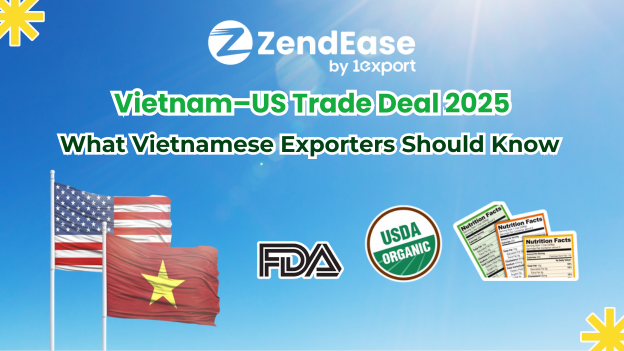How the Vietnam — US Trade Deal 2025 Impacts Exporters: What Vietnamese Businesses Should Know
by Ly Nguyen on Oct 07, 2025

The newly signed Vietnam–US Trade Deal 2025 marks a significant milestone in strengthening economic ties between the two countries. For Vietnamese exporters, this agreement is both a doorway to new opportunities and a reminder of the challenges that come with entering one of the world’s most demanding markets.
One of the biggest benefits of the deal is greater access to the US market. Tariffs on key Vietnamese exports — including textiles, garments, seafood, coffee, cashew nuts, pepper, furniture, and electronics — are being reduced, allowing local businesses to compete more effectively on price. This is especially significant at a time when US buyers are seeking to diversify supply chains beyond China. For a textile manufacturer in Binh Duong or a shrimp processor in the Mekong Delta, the deal could mean stronger margins and the ability to secure long-term contracts with American partners.
But easier access doesn’t mean easier acceptance. US buyers and regulators remain firm on issues of quality, safety, and sustainability. Take seafood, for instance: shrimp and pangasius exporters will need to demonstrate traceability and meet certifications such as ASC or BAP to satisfy importers. Coffee and cashew producers are expected to obtain USDA Organic, Fair Trade, or Rainforest Alliance labels if they want to position themselves at the premium end of the market. Even garment manufacturers will need to prove compliance with labor rights and environmental standards. For many exporters, upgrading production processes and obtaining certifications will be an unavoidable investment — and one that pays off through credibility and higher-value contracts.
The trade deal also aims to make logistics smoother. Streamlined customs procedures and reduced red tape can help Vietnamese goods reach US buyers more quickly and predictably. This matters most for perishable products like fruit and seafood, where every day saved translates into fresher deliveries and reduced costs. A dragon fruit exporter in Binh Thuan, for example, will now have greater confidence in meeting the tight schedules demanded by US retailers. Exporters who embrace digital logistics tools and invest in cold chain systems will be well placed to turn these improvements into tangible advantages.
Small and medium-sized enterprises (SMEs) are among the biggest potential winners of this deal. With US companies actively seeking alternative suppliers, smaller Vietnamese businesses have an opening to showcase their niche strengths. Specialty coffee from Buon Ma Thuot, handcrafted wooden furniture from Dong Nai, or eco-friendly handicrafts from village cooperatives can now appeal to American buyers who value authenticity and unique stories. In fact, it’s often SMEs that have the flexibility to adapt quickly to trends such as sustainability or ethical sourcing — factors increasingly important to US consumers.
Of course, opportunities come hand in hand with challenges. The US market is highly competitive, and tariff reductions apply to everyone. Mexico, India, and Thailand will also be pushing harder into the same space. Even within Vietnam, larger exporters with deeper pockets may dominate mainstream categories, leaving smaller players to find their footing in specialized markets. Moreover, US consumers are more conscious than ever about where their products come from, how they are made, and what environmental impact they leave behind. To stay relevant, Vietnamese exporters must not only sell a product but also a story of responsibility, quality, and innovation.
This is where preparation and partnership become critical. Exporters should be asking: Which certifications are necessary for my industry? How can I optimize logistics to cut costs and ensure reliability? What makes my product stand out in the eyes of US buyers? The answers will determine who thrives under this new agreement.
At ZendEase by 1Export, our mission is to help Vietnamese businesses navigate this complex journey. We support exporters with compliance documentation, FDA and USDA registration, labeling requirements, and logistics solutions that simplify the process of reaching US buyers. For SMEs and established players alike, we also provide strategies for cross-border e-commerce and B2B sales channels, ensuring that products not only meet standards but also find the right markets.
The Vietnam–US Trade Deal 2025 represents a rare moment of opportunity. For exporters of seafood, coffee, textiles, furniture, and agricultural specialties, it opens the door wider than ever before. But walking through that door requires preparation — investing in compliance, strengthening logistics, and building a brand that resonates with US buyers. With the right approach and the right partners, Vietnamese businesses can turn this agreement into a foundation for long-term growth and international recognition.
